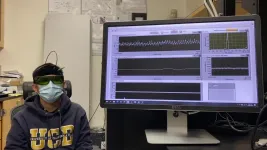(Press-News.org) New research presented at this year's European Congress on Obesity (held online, 10-13 May) shows that the obesity drug semaglutide reduces appetite, food cravings and energy intake in people given a meal where they could eat as much as they liked. The study is by Dr Dorthe Skovgaard, Novo Nordisk A/S (the manufacturer of the drug), Søborg, Denmark, and colleagues.
Semaglutide, in the glucagon-like peptide-1 (GLP-1) analogue drug class, is currently available at the dose of 1.0 mg injected once weekly for the treatment of type 2 diabetes and is under development for chronic weight management at the dose 2.4 mg injected once weekly. It is currently not approved for obesity anywhere in the world, however new drug applications are under review by the US Food and Drug Administration (FDA), the European Medicines Agency (EMA), and other health agencies across the world.
The STEP trials, that have been published in various journals over the past year, have established the efficacy and safety of semaglutide 2.4 mg to treat people living with obesity. Semaglutide lowers body weight by reducing appetite and hunger, increasing satiety, reducing food cravings, altering food preferences and reducing energy intake. GLP-1 receptor agonists can lead to delays in gastric emptying, which may be important for the uptake of other drugs.This trial investigated the effect of semaglutide 2.4 mg on gastric emptying, energy intake, appetite and control of eating in subjects with obesity.
Adults aged 18-65 years, with a body mass index (BMI) 30-45 kg/m² (with various stages of obesity) and without type 2 diabetes, were randomised in a double-blind, parallel-group trial to treatment with semaglutide 2.4 mg (dose gradually escalated: 0.25, 0.5, 1.0 and 1.7 mg for 4 weeks each; 2.4 mg for 5 weeks) or placebo. The dose of semaglutide was gradually scaled up, as is standard to improve gastrointestinal tolerability.
Gastric emptying (using a standard test called the paracetamol absorption test, 1.5 g paracetamol given with a standardised breakfast) was assessed during in-house visits at baseline and week 20.
Postprandial (after-meal) appetite was evaluated using standard tests called visual analogue scales pre-meal and following a standardised breakfast, followed by assessment of energy intake during a lunch in which participants could freely choose how much they ate (an 'ad libitum' lunch). Control of eating and food cravings were evaluated by the Control of Eating Questionnaire (CoEQ) - a questionnaire to assess the severity and type of food cravings an individual experiences over the previous 7 days. Safety was also evaluated.
In total, 72 subjects were randomised (44 males, mean age 42.8 years, BMI 34.4 kg/m²); 70 completed the study. There was no evidence of delayed gastric emptying at week 20, as assessed indirectly via paracetamol absorption. Mean energy intake during the ad libitum lunch test meal at week 20 was 35% lower with semaglutide 2.4 mg vs placebo (1736 vs 2676 kJ); estimated treatment difference 940 kJ, both statistically significant findings.
The overall appetite score showed significant reduction in appetite with semaglutide 2.4 mg vs placebo; individual appetite components showed significant reductions in 'hunger' and 'prospective food consumption' and increases for 'fullness' and 'satiety'. In general, CoEQ indicated fewer and weaker food cravings, notably reduced cravings for savoury foods and better control of eating with semaglutide 2.4 mg vs placebo. All results detailed here were statistically significant. No new safety signals were seen.
The authors conclude: "In subjects with obesity, semaglutide 2.4 mg suppressed appetite and reduced the frequency and strength of food cravings. Energy intake during a lunch at week 20 in which participants were free to eat as much as they wanted was 35% lower with semaglutide 2.4 mg vs placebo. There was also no clinically relevant effect on gastric emptying with semaglutide 2.4 mg at steady state, measured by paracetamol uptake."
They add: "Control of appetite and reduced frequency and strength of food cravings are important for weight management in people living in obesity, especially in a society which promotes unhealthy lifestyles and overeating."
INFORMATION:
An early study of a new experimental drug to treat obesity known as cagrilintide shows that, when combined with semaglutide 2.4 mg, the combination leads to more weight loss than semaglutide 2.4 mg alone and is well tolerated. This phase 1 study, which was recently published in The Lancet will be presented at this year's European Congress on Obesity (held online, 10-13 May) by Dr Lone Enebo, Novo Nordisk A/S, Denmark, on behalf of her colleagues. Novo Nordisk A/S is the manufacturer of both drugs in this study.
Combining medications with different modes of action may provide more effective treatment options for people with obesity. Weekly injections of cagrilintide, ...
Two-thirds of California prisoners who were offered a COVID-19 vaccine accepted at least one dose, according to a new study by researchers at the Stanford University School of Medicine.
"We found that many incarcerated people in California prisons were willing to be vaccinated for COVID-19," said Elizabeth Chin, the lead author of the study and a PhD candidate in biomedical data science. "This is an encouraging sign for other states at an early stage of rolling out vaccination programs in their prisons and jails."
The researchers also found that nearly half of those who initially turned down a COVID-19 vaccine accepted it when it was offered to them again. The finding is an important indication that vaccine hesitancy is not necessarily fixed.
Two-thirds ...
The 1949 letter by the physicist and Nobel laureate discusses bees, birds and whether new physics principles could come from studying animal senses.
It's a position still being realised within physics to this day, with a growing body of research and understanding of how animals such as birds and bees find their way around.
Now a study led by RMIT University in Melbourne, Australia, discusses how recent discoveries in migratory birds back up Einstein's thinking 72 years ago.
The previously unpublished letter was shared with researchers by Judith Davys - Einstein had addressed ...
If you did not catch the flu this year -- and there is an overwhelming chance that you did not -- you have COVID-19 to thank.
It's a small consolation, given the enormously disruptive scope of the pandemic. But it's the focus of a new paper published in the journal Frontiers in Public Health by two Concordia researchers and their colleagues that studies the 2020 influenza figures from Canada, the United States, Australia and Brazil. The authors show there is a clear relationship between the implementation of COVID-mitigation measures such as hand-washing, masking and social distancing and the spread of the annual flu.
They write that these preventive measures all but eliminated ...
The quest to create safer, more successful pregnancies is one of the top goals of modern science. While pregnancy is better understood today than ever before, with improvements in technology helping to lower the risk of negative outcomes, there is much researchers still don't know about a vital part of the pregnancy process: uterine fluid.
Secreted by glands in the uterus during pregnancy, uterine fluid is believed to play an important role in supporting a developing embryo by sending information from the uterus to the embryo, along with a host ...
In 2020, stores sold out of garden seed, coops and rabbit cages. Now, we have an idea how much protein people can grow in their backyards.
The 2020 meat shortages led many to wonder what to eat for protein when supply chains are disrupted. Some people turned to gathering eggs, raising animals and growing their own food. A team from Michigan Technological University and the University of Alaska Fairbanks found that the work is well worth it. In a new study published in Sustainability, the researchers looked at how a typical household with a typical backyard can raise chickens, rabbits or soybeans to meet its protein needs.
People eat a lot of protein in the U.S. and the average person needs 51 grams of ...
MINNEAPOLIS/ST.PAUL (05/12/2021) -- In a study recently published in END ...
DURHAM, N.H.-- A national report from the University of New Hampshire shows close to one and a half million children each year visit a doctor, emergency room or medical facility as a result of an assault, abuse, crime or other form of violence. This is four times higher than previous estimates based only on data from U.S. emergency rooms for violence-related treatment.
In their END ...
A portable, rapid testing platform can detect gonorrhea infections in patient samples in under 15 minutes, far faster than standard-of-care tests that can take hours or days. The platform accurately detected infections and determined resistance to a common antibiotic in 217 patient samples from sexual health clinics in Baltimore and Uganda. The technology's speed and low cost could empower quicker and more affordable gonorrhea testing in low-resource regions, as well as help combat the spread of drug-resistant strains. Rates of gonorrhea and other sexually transmitted ...
A new, noninvasive method for measuring brain blood flow with light has been developed by biomedical engineers and neurologists at the University of California, Davis, and used to detect brain activation. The new method, functional interferometric diffusing wave spectroscopy, or fiDWS, promises to be cheaper than existing technology and could be used for assessing brain injuries, or in neuroscience research. The work is published May 12 in Science Advances.
"Now we can assess how well the brain regulates blood flow, and even detect brain activation noninvasively in adult humans, using principles similar to functional ...




